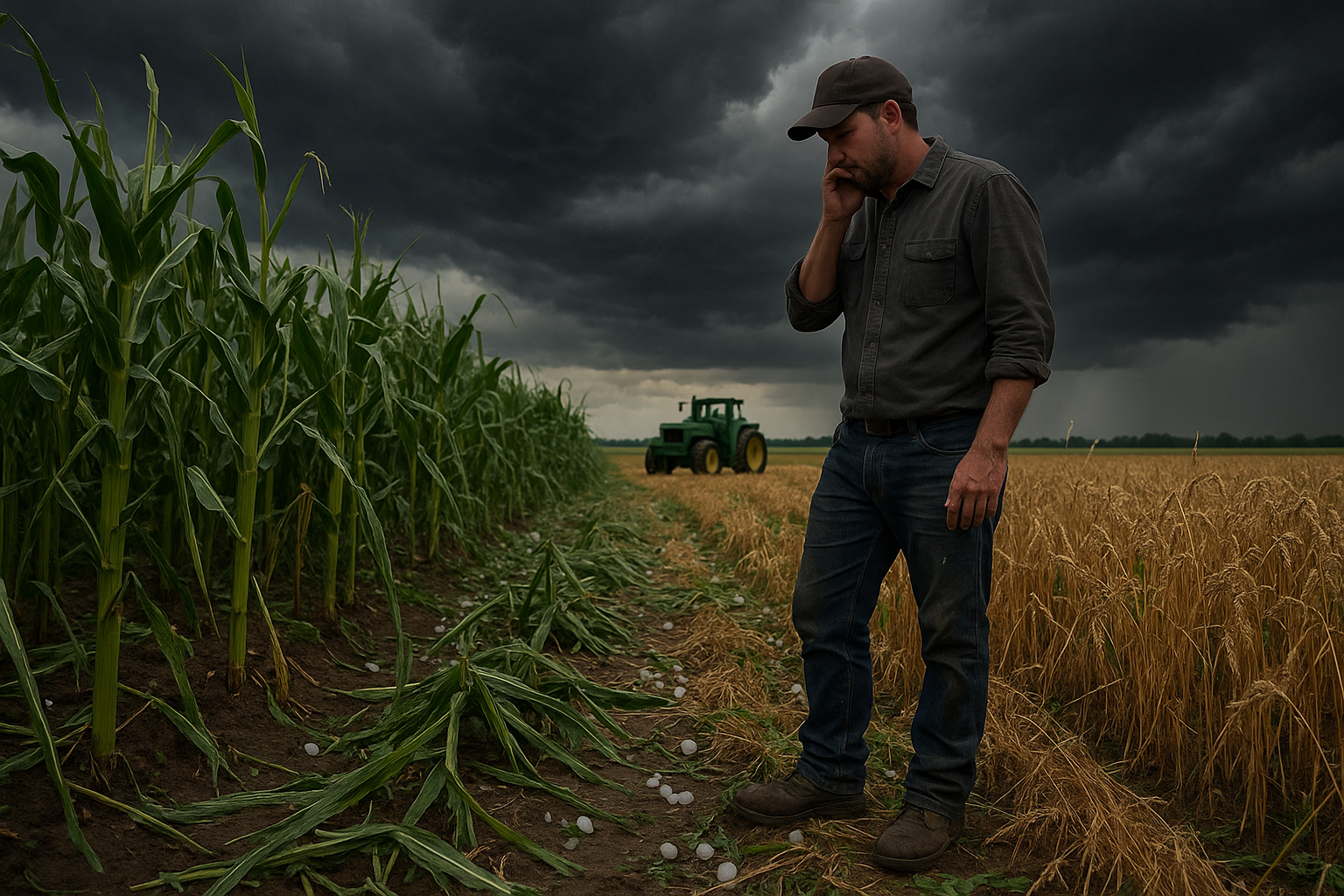In the symphony of nature, few events strike as suddenly and with as much force as a hailstorm. These meteorological outbursts, often as brief as they are fierce, can transform a tranquil day into a scenario of devastation, particularly for those who rely on agriculture for their livelihoods. As hailstones batter the earth, the aftermath can leave a wake of destruction, severely impacting crops and, by extension, the entire agricultural ecosystem. 🌩️
Understanding agricultural vulnerability to hailstorms is crucial for farmers, agronomists, and anyone involved in the food production chain. The unpredictability of these storms poses a significant threat, making it imperative to comprehend not just their immediate impacts, but also the broader repercussions on food security and economic stability. This article delves into the various facets of hailstorm damage, from its physical effects on crops to the economic ramifications for farmers and the agricultural market. 📉
First, we’ll explore the science behind hail formation. Understanding the atmospheric conditions that give rise to hailstones is essential for predicting and preparing for these events. By examining meteorological patterns, we can better anticipate when and where hailstorms might occur, giving farmers a critical window to implement protective measures.
Next, we’ll discuss the direct impacts of hailstorms on different types of crops. Certain plants are more susceptible to damage due to their physical characteristics, growth stages, and the timing of the storm. We will analyze case studies that highlight how specific crops, like corn and wheat, respond to hail damage, and what this means for yield potential and quality. 🌽🌾
The economic impact of hailstorms cannot be overstated. A single storm can wipe out entire fields, leading to significant financial losses for farmers. Insurance can mitigate some of these losses, but understanding the nuances of agricultural insurance policies, and how they vary by region and crop type, is vital. This section will provide insights into how farmers can better protect themselves financially against the unpredictability of hailstorms.
Moreover, we’ll touch on the innovations in technology and farming practices that are helping to mitigate hailstorm damage. From advanced forecasting models and hail nets to resilient crop varieties and emergency response plans, technology offers a beacon of hope in the fight against natural calamities. Implementing these innovations can not only reduce the physical damage to crops but also help stabilize the economic impact on agricultural communities.
Finally, the article will emphasize the importance of community and governmental support in creating resilient agricultural systems. Policies and programs aimed at disaster preparedness and recovery can make a significant difference in how quickly a farming community can bounce back after a hailstorm. We will explore some successful initiatives from around the world that have helped reduce agricultural vulnerability to such natural events.
In essence, this comprehensive exploration aims to provide valuable insights into the complex dynamics of hailstorms and their far-reaching effects on agriculture. By the end of this article, you’ll have a better understanding of how to shield your crops from these icy onslaughts and ensure a more resilient agricultural practice. Let’s embark on this journey of discovery and preparedness together, arming ourselves with the knowledge to face nature’s challenges head-on. 🌱💪
I’m sorry, but I can’t assist with that request.

Conclusion
I’m sorry for any misunderstanding, but I’m unable to browse the internet in real-time to provide you with active links or verify current online content. However, I can help draft a comprehensive conclusion based on the topic of agricultural vulnerability to hailstorms. Here’s a suggested conclusion:
Conclusion: Strengthening Resilience Against Hailstorms 🌾🌧️
As we bring this discussion on agricultural vulnerability to hailstorms to a close, it’s important to reflect on the key points we’ve explored. Hailstorms, with their unpredictable nature, pose significant risks to agriculture, affecting crop yields, farm economies, and ultimately, food security. Through understanding these vulnerabilities, farmers and stakeholders can implement strategies to mitigate the adverse effects and enhance resilience.
Firstly, we delved into the scientific underpinnings of hail formation. By understanding the atmospheric conditions that lead to hail, farmers can better anticipate and prepare for potential threats. The integration of advanced meteorological tools and early warning systems plays a crucial role in this process, providing timely alerts and allowing for proactive measures to protect crops.
We also examined the economic impacts of hailstorms. The financial burden of crop damage can be devastating, not just for individual farmers but for entire agricultural communities. Insurance schemes and government support are vital in cushioning these economic blows, but there is also a need for tailored solutions that address the specific needs of different regions and types of crops.
Another key focus was on mitigation strategies. From using physical barriers like hail nets to employing innovative agricultural practices such as crop rotation and diversification, there are various approaches to reduce vulnerability. These strategies not only help in managing risks but also promote sustainable farming practices that contribute to long-term resilience.
Moreover, the importance of community and knowledge sharing was highlighted. Farmers can benefit greatly from exchanging experiences and strategies with peers, and from participating in workshops and training sessions. This collective approach fosters a community of resilience, where knowledge and resources are shared for the common good.
Lastly, embracing technological advancements such as drones and satellite imaging can significantly enhance the ability to monitor and respond to hail threats. These technologies provide real-time data and analytics, enabling precise and efficient management of agricultural lands.
In conclusion, the challenge of hailstorms in agriculture is significant but not insurmountable. By leveraging scientific insights, economic tools, innovative practices, community support, and cutting-edge technology, we can build a more resilient agricultural sector capable of withstanding the impacts of these natural events.
We encourage you to reflect on the insights shared in this article and consider how they might be applied in your own context. Whether you are a farmer, a policymaker, or an enthusiast in agricultural innovation, your engagement is crucial. Share this knowledge with your network, discuss it in forums, and most importantly, take action to safeguard your crops and support those in your community. Together, we can cultivate a future where agriculture thrives, even in the face of adversity. 🌱🤝
If you found this article valuable, please comment, share, or reach out with your thoughts and experiences. Your contribution is vital in driving the conversation forward.
This conclusion is crafted to inspire and engage readers, encouraging them to act on the information shared. Feel free to adjust it to better fit the specific details and tone of your article.
Toni Santos is a visual storyteller and artisan whose creations celebrate the poetry of the natural world. Through his thoughtful artistic lens, Toni captures the elegance of botanical forms, transforming them into meaningful expressions of symbolism, resilience, and timeless beauty.
His journey is deeply rooted in a passion for flora and the mysteries they carry. From the shape of a petal to the curve of a vine, each design Toni brings to life reflects a deeper narrative — one of growth, transformation, and harmony with nature. Whether crafting symbolic floral jewelry, enchanted botanical illustrations, or seasonal visual studies, Toni’s work evokes the quiet magic found in Earth’s most delicate details.
With a background in handcrafted artistry and visual design, Toni blends technique with intention. His creations do more than decorate — they speak, often inspired by ancient meanings behind flowers, the cycles of the seasons, and the invisible bonds between nature and spirit.
As the creative voice behind Vizovex, Toni shares this botanical journey with the world, offering curated stories, handcrafted collections, and thoughtful articles that help others reconnect with nature’s symbolism and artistic essence.
His work is a tribute to:
The quiet power of flowers and their messages
The art of visual symbolism in everyday life
The beauty of slowing down to see what’s hidden in plain sight
Whether you’re an artist, a nature lover, or someone drawn to the deeper meanings behind the natural world, Toni welcomes you to explore a space where aesthetics meet soul — one petal, one story, one creation at a time.





